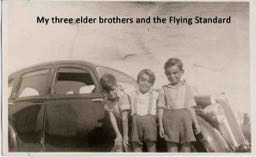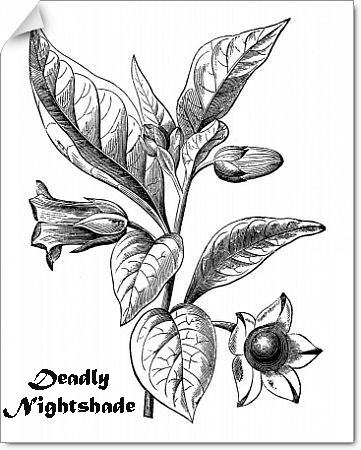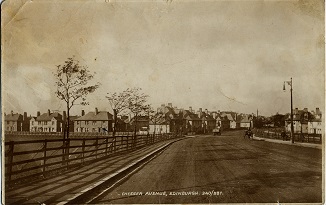So much have been said about all our road trips and adventures and yet I haven’t given enough spotlight to our tireless companions: the family’s classic cars.
Life for us was fairly regimental, and my father worked most of the time; we would either be at school or usually outside playing. Holidays were ritual-like, especially in those days, because they had to be planned far ahead.
The car was the centrepiece of the holidays since it provided the means to a cottage or a caravan in the summer. It was also where we had our adventurous drives to a seaside resort on weekends. Though I can’t always remember specific details, something I am sure of is that everyone was happier when on holiday.
My mother, I remember, was quite childlike and super excited when going to Scotland or the seaside. She would love the drive to Blackpool ‘to see the lights’, and would be quite thrilled when we got there. It’s difficult to imagine adults these days showing a similar child-like fascination for something like the Blackpool Lights! But my mother was different, she loved what she loved and nothing could keep her from her little joys.
Magnificent Wolseley 12
I have a memorable experience riding the Wolseley 12 which I will be talking about in a separate post. For now, I’d like to introduce you to its features. I believe it was a 1949 model, although its design resembles that of the 1937 pre-war cars.
From the photo, it’s easy to see that the chrome radiator was perhaps its best feature; it was something the top automobile manufacturers spent a little more time on to make a statement.
The grille had a ‘Wolseley’ badge at the top, inside the chrome surround; it lit up at night showing ‘Wolseley’, and was already a cool feature back then. Just in case you’re still unsure of the car’s make, there was a radiator cap with a ‘W’ shape to confirm that the engineering was by Wolseley.
That radiator cap was one of the most used parts of the car, as the engine often ‘cooked’. It is a typical occurrence especially if you decided to pull a caravan around the hilly Lake District on a hot day. The engine was designed in the 1930s or perhaps earlier. It had a 1500 cc capacity, registered as 12 horsepower, and produced about 40 BHP.
Another amazing feature of the car was that you could open the windscreen by turning a chrome handle on the dashboard. This was much appreciated on those hot summer trips. It also had a sliding roof, running boards, and enormous external chrome headlights decorating curvaceous wings. The bonnet opened upwards on both sides and was fluted. The boot lid was hinged at the bottom, so that when it was opened it would provide a horizontal platform for any extra luggage.
The car was also designed as a luxury machine and came with a characteristic wood and leather interior, with bucket-type seats at the front, and a handbrake between these. I remember the handbrake very well because being the youngest, I had to sit on it with a cushion in between the brake handle and my bum. Otherwise, I’d be squeezed to death by the rest of the boys in the back seat.
Although it was a position of honour to sit next to my father, the Captain of the Wolseley 12 ‘ship’, it was pretty uncomfortable on long journeys. I might have done other things to injure my back over the years, but I have always blamed this sitting position for the back problems that bedevilled me later in life.
Wolseley 12 and Modern Cars
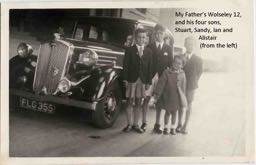
The car was painted in British racing green. This was quite an elegant colour and seemed to give onlookers the idea that this was a fast machine. I always believed the car had racing speed in it since my father used to boast that it had an MG engine. There may have been some truth in this, because MG cars were actually Morris cars; the MG standing for ‘Morris Garage’, and the fact that Wolseley was bought out by Morris Motors in 1927. In other words, the Wolseley’s 1548 cc engine was also used by MG and Morris cars.
However, the engine was pretty weak by modern standards, and even by 1950s standards. It had a heavy bodywork that was aimed at making it look elegant at the expense of making a lighter car. Nevertheless, my father didn’t think the engine was ‘weak’ at the time. Obviously, I shared his opinion as I was just a child.
Even after driving modern cars, I can still look back and think that the Wolseley was a pretty fast car. One time when we were on holiday, with the car fully loaded with luggage and kids, my father had it going at a neck-breaking 72 mph. The speedometer was only inches from my nose, as I was sitting on my usual cushion on the break.
This car also seemed large to me growing up. However, I suddenly doubted that when I was talking to a ‘chess’ friend in Oslo when I was already older. I was telling him that it was a big car that you could stand up in, unlike modern cramped cars. He logically pointed out (typical chess player!) how easy it would be for a six or seven-year-old to stand up in just about any car. This made me realize that the car wasn’t perhaps as big as I thought.
Flying Standard
Before owning a Wolseley 12, my father drove a Flying Standard. I can’t say much about this car because I was still a baby or at least very young. My father must have bought the Wolseley 12 around 1953. However, the Flying Standard often came up in family conversations, and its iconic photos were all over the family photo album dating back to the 1940s.
Just the name of the Flying Standard sounded racy, never mind its streamlined looks. Yet, I remember my father wasn’t that impressed with the car. It was smaller than the Wolseley 12, and I think it was mechanically unreliable, requiring my father to ‘upgrade’ to the Wolseley.
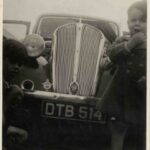

Other Classic Cars
Gavin, my younger brother, was born when I was nine years old. We ‘graduated’ to a two-tone grey Mk VI Humber Hawk not long after he was born in Culcheth. When my father sold this car, it wasn’t only the British Empire that had gone into decline, but also the family also in terms of automotive. We owned a series of rather embarrassingly tinny models, such as a Ford Anglia, Austin 1100, and Ford Cortina. But by the 1960s, cars had somewhat stopped making impressions as markers of social status.

My brother, Alistair, tried to re-establish the family ‘honour’ by purchasing first a black Mk VI Humber Hawk identical to my father’s, and then a Mark VII Jaguar, which he bought from Jim Lowry, a local Jaguar enthusiast, whose back garden was always full of amazing Jaguars. I later bought this same Humber for £20 together with my friend John Barker, and we hand-painted it midnight blue in special ‘polyurethane’ paint, which John insisted on, and we also white-walled the tyres. I also bought a white Mk VII Jaguar from Jim Lowry for £20, which I had won in a poker game at the Constitutional Club in Billericay.
My mother had already vetoed my previous purchase of a WWII BSA bantam motorbike. The bantam’s engine later seized – it was a two-stroke and they gave me the wrong mixture at the petrol station. I also had a 1930s Chrysler she didn’t like, which ended up being towed away by the local council. She also didn’t give much love to the purchase of the white MK VII Jaguar, which I had parked on a bit of wasteland next to the house. So I had to drive it back to Jim Lowry. She had a new 1965 white Austin 1100, and said my 1957 white MK VII Jaguar was bringing down the tone of the (‘Hyacinth Bucket’) neighbourhood!
But I’m putting the cart before the horse here, as this was when I was a teenager, and we were living in Billericay, Essex. So this will be reported on in more detail in “Recollections 2”. But as an afterthought, the market price of a Mk VII Jaguar today (2022) is $25 000, whereas, the market price of an Austin 1100 is $8000.


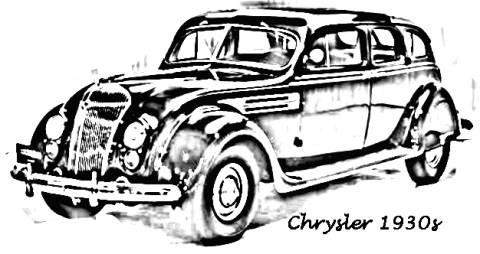
Other posts talking about our cars are the following:
